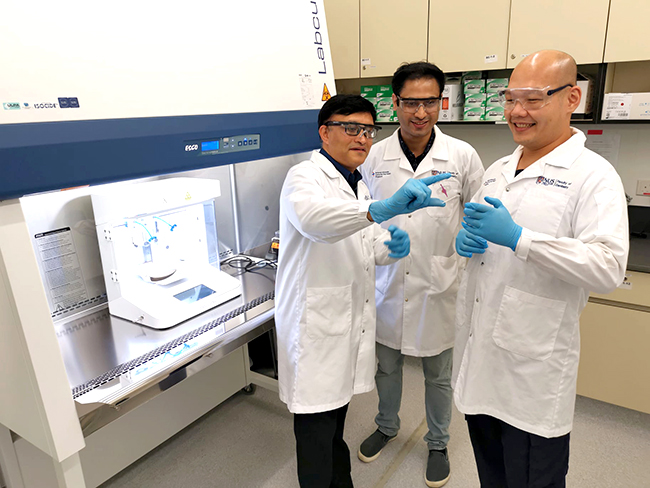News
Microfluidic Tooth-on-a-Chip: Understanding the Effect of Dental Materials on Dental Pulp
At the Faculty of Dentistry (FoD), our researchers constantly embark on research to examine the impact of dental materials on the dental pulp to advance knowledge on the safety and efficacy of various treatment approaches. Traditionally, researchers study such interactions by exposing cells cultured on flat dishes to different dental materials. Such lab-based models, however, do not mimic the barrier function of dentin and blood flow to the pulp tissue. Researchers can resort to animal models, which raises questions about their physiological relevance to humans and other ethical issues.

The Faculty’s researchers developed the “Tooth-on-a-Chip” to examine interactions between dental
materials and dental pulp stem cells.
To address such challenges, a team of FoD researchers led by Dr Gopu Sriram and Dr Hu Shijia developed a microfluidic organ-on-a-chip device called the “Tooth-on-a-Chip” to assess the interactions between dental materials and dental pulp stem cells. A grant from the Singapore Dental Association Endowment Fund supported this study.
The study, published in Dental Materials (a journal for Oral and Craniofacial Biomaterials Science and the official publication of The Academy of Dental Materials), investigated the impact of Silver Diamine Fluoride (SDF) on dental pulp stem cells and the barrier potential of dentin. SDF is considered a safe and effective alternative technique for caries management, but researchers must continue to evaluate its benefits as well as its limitations. Using the “Tooth-on-a-Chip” device, researchers could emulate the blood flow to pulp cells and dentin barrier under different clinical scenarios. With this new tool, they tested out the effects of SDF on dental pulp stem cells under simulated deep cavities. The authors found that SDF penetrates dentin of lower thicknesses (≤1.0 millimetres) and affects the health of pulp cells beneath.
The SDF is the first dental material tested using the “Tooth-on-a-Chip” device. The study shows the device's potential to mimic the microenvironment of the human dental pulp and opens the gateway for more dental materials to be examined using this approach.
“This research offers excellent insights into the power of tissue engineering and microfluidic technology. Both technologies intertwine various disciplines, including engineering, physics, fluid dynamics, and biotechnology, yet they could be powerfully applied to dentistry. This allows us to understand the safety and efficacy of dental materials and at the same time, reduce (if not replace) the use of animals in dental research.” said Dr Gopu Sriram.
“Being a clinician scientist, the study allows me to work with basic scientists and clinicians to frame research questions which will have clinical applications down the road. Working with Dr Sriram and his team was especially satisfying because it enabled me to understand how research on dental pulp stem cells can be done on a device out of the human mouth. I am sure this will inspire more studies which will deepen our knowledge on oral diseases and treatment approaches and hopefully impact the community's health in the long run,” added Dr Hu Shijia.

